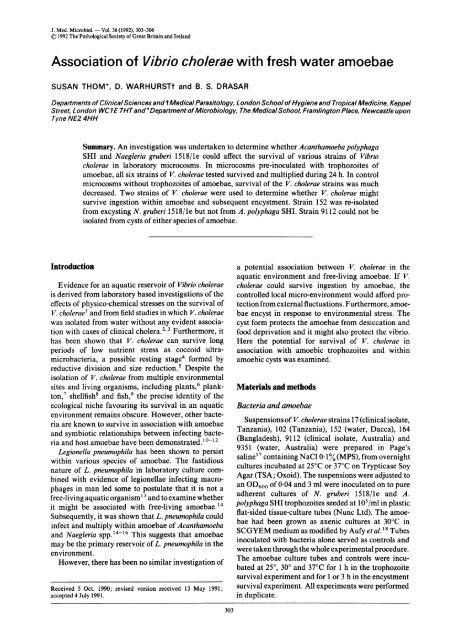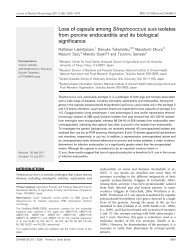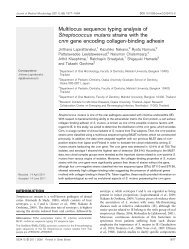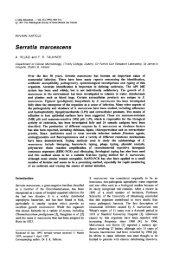Association of Vibrio cholerae with fresh water amoebae - Journal of ...
Association of Vibrio cholerae with fresh water amoebae - Journal of ...
Association of Vibrio cholerae with fresh water amoebae - Journal of ...
You also want an ePaper? Increase the reach of your titles
YUMPU automatically turns print PDFs into web optimized ePapers that Google loves.
J. Med. Microbiol. - Vol. 36 (1992), 303-306<br />
0 1992 The Pathological Society <strong>of</strong> Great Britain and Ireland<br />
<strong>Association</strong> <strong>of</strong> <strong>Vibrio</strong> <strong>cholerae</strong> <strong>with</strong> <strong>fresh</strong> <strong>water</strong> <strong>amoebae</strong><br />
SUSAN THOM*, D. WARHURSTt and B. S. DRASAR<br />
Departments <strong>of</strong> Clinical Sciences and t Medical Parasitolog y, London School <strong>of</strong> Hygiene and Tropical Medicine, Keppel<br />
Street, London WC 1 E 7HT and *Department <strong>of</strong> Microbiology, The Medical School, Framlington Place, Newcastle upon<br />
Tyne NE2 4HH<br />
Introduction<br />
Summary. An investigation was undertaken to determine whether Acanthamoeba polyphaga<br />
SHI and Naegleria gruberi 1518/le could affect the survival <strong>of</strong> various strains <strong>of</strong> <strong>Vibrio</strong><br />
<strong>cholerae</strong> in laboratory microcosms. In microcosms pre-inoculated <strong>with</strong> trophozoites <strong>of</strong><br />
<strong>amoebae</strong>, all six strains <strong>of</strong> V. choZerae tested survived and multiplied during 24 h. In control<br />
microcosms <strong>with</strong>out trophozoites <strong>of</strong> <strong>amoebae</strong>, survival <strong>of</strong> the V. <strong>cholerae</strong> strains was much<br />
decreased. Two strains <strong>of</strong> V. <strong>cholerae</strong> were used to determine whether V. <strong>cholerae</strong> might<br />
survive ingestion <strong>with</strong>in <strong>amoebae</strong> and subsequent encystment. Strain 152 was re-isolated<br />
from excysting N. gruberi 15 1 8/ 1 e but not from A. polyphaga SHI. Strain 9 1 12 could not be<br />
isolated from cysts <strong>of</strong> either species <strong>of</strong> <strong>amoebae</strong>.<br />
Evidence for an aquatic reservoir <strong>of</strong> <strong>Vibrio</strong> <strong>cholerae</strong><br />
is derived from laboratory based investigations <strong>of</strong> the<br />
effects <strong>of</strong> physico-chemical stresses on the survival <strong>of</strong><br />
V. <strong>cholerae</strong>l and from field studies in which V. <strong>cholerae</strong><br />
was isolated from <strong>water</strong> <strong>with</strong>out any evident association<br />
<strong>with</strong> cases <strong>of</strong> clinical cholera.293 Furthermore, it<br />
has been shown that V. <strong>cholerae</strong> can survive long<br />
periods <strong>of</strong> low nutrient stress as coccoid ultramicrobacteria,<br />
a possible resting stage4 formed by<br />
reductive division and size reduction.' Despite the<br />
isolation <strong>of</strong> V. <strong>cholerae</strong> from multiple environmental<br />
sites and living organisms, including plants,6 plankton,7<br />
shellfish' and fish,' the precise identity <strong>of</strong> the<br />
ecological niche favouring its survival in an aquatic<br />
environment remains obscure. However, other bacteria<br />
are known to survive in association <strong>with</strong> <strong>amoebae</strong><br />
and symbiotic relationships between infecting bacteria<br />
and host <strong>amoebae</strong> have been demonstrated. ''-I2<br />
Legionella pneumophila has been shown to persist<br />
<strong>with</strong>in various species <strong>of</strong> <strong>amoebae</strong>. The fastidious<br />
nature <strong>of</strong> L. pneumophiza in laboratory culture combined<br />
<strong>with</strong> evidence <strong>of</strong> legionellae infecting macrophages<br />
in man led some to postulate that it is not a<br />
free-living aquatic organism' and to examine whether<br />
it might be associated <strong>with</strong> free-living <strong>amoebae</strong>.14<br />
Subsequently, it was shown that L. pneumophila could<br />
infect and multiply <strong>with</strong>in <strong>amoebae</strong> <strong>of</strong> Acanthamoeba<br />
and Naegleria ~pp.'~-'~ This suggests that <strong>amoebae</strong><br />
may be the primary reservoir <strong>of</strong> L. pneumophila in the<br />
environment.<br />
However, there has been no similar investigation <strong>of</strong><br />
Received 5 Oct. 1990; revised version received 13 May 1991;<br />
accepted 4 July 1991.<br />
303<br />
a potential association between V. <strong>cholerae</strong> in the<br />
aquatic environment and free-living <strong>amoebae</strong>. If V.<br />
<strong>cholerae</strong> could survive ingestion by <strong>amoebae</strong>, the<br />
controlled local micro-environment would afford pro-<br />
tection from external fluctuations. Furthermore, amoe-<br />
bae encyst in response to environmental stress. The<br />
cyst form protects the <strong>amoebae</strong> from desiccation and<br />
food deprivation and it might also protect the vibrio.<br />
Here the potential for survival <strong>of</strong> V. <strong>cholerae</strong> in<br />
association <strong>with</strong> amoebic trophozoites and <strong>with</strong>in<br />
amoebic cysts was examined.<br />
Materials and methods<br />
Bacteria and <strong>amoebae</strong><br />
Suspensions <strong>of</strong> V. <strong>cholerae</strong> strains 17 (clinical isolate,<br />
Tanzania), 102 (Tanzania), 152 (<strong>water</strong>, Dacca), 164<br />
(Bangladesh), 91 12 (clinical isolate, Australia) and<br />
9351 (<strong>water</strong>, Australia) were prepared in Page's<br />
saline17 containing NaClO.l% (MPS), from overnight<br />
cultures incubated at 25°C or 37°C on Trypticase Soy<br />
Agar (TSA; Oxoid). The suspensions were adjusted to<br />
an OD6'' <strong>of</strong> 0.04 and 3 ml were inoculated on to pure<br />
adherent cultures <strong>of</strong> N. gruberi 1518/le and A.<br />
polyphaga SHI trophozoites seeded at 105/ml in plastic<br />
flat-sided tissue-culture tubes (Nunc Ltd). The amoe-<br />
bae had been grown as axenic cultures at 30°C in<br />
SCGYEM medium as modified by Aufy et al. ' ' Tubes<br />
inoculated <strong>with</strong> bacteria alone served as controls and<br />
were taken through the whole experimental procedure.<br />
The <strong>amoebae</strong> culture tubes and controls were incu-<br />
bated at 25", 30" and 37°C for 1 h in the trophozoite<br />
survival experiment and for 1 or 3 h in the encystment<br />
survival experiment. All experiments were performed<br />
in duplicate.
304 S. THOM, D. WARHURST AND B. S. DRASAR<br />
Survival u f V. <strong>cholerae</strong> in truphozuites<br />
Amoebae were exposed to V. <strong>cholerae</strong> as outlined<br />
above. After incubation for I h, unattached bacteria<br />
were decanted and the tubes were rinsed <strong>with</strong> MPS.<br />
Tubes were placed in an ice-bath to detach the<br />
<strong>amoebae</strong> which were then resuspended in MPS.<br />
Suspended <strong>amoebae</strong> (0.1 ml) were inoculated on to<br />
non-nutrient agar (“A) overlaid <strong>with</strong> heat inacti-<br />
vated Escherichia coli and incubated at 30°C for up to<br />
7 days to confirm the presence <strong>of</strong> viable trophozoites.<br />
Ten-fold serial dilutions were prepared from the<br />
suspensions <strong>of</strong> <strong>amoebae</strong>, and from suspensions that<br />
had been freeze-thawed once, and 0-1-ml portions<br />
spread on to TSA at pH 8-6. Plates were incubated<br />
overnight at 37°C and colonies were counted.<br />
In a second series <strong>of</strong> experiments, following the<br />
rinse after incubation for 1 h, the tubes were refilled<br />
<strong>with</strong> MPS and re-incubated for 24h before further<br />
processing as above.<br />
Surfiival <strong>of</strong> V. <strong>cholerae</strong> in cysts<br />
After challenge <strong>of</strong> <strong>amoebae</strong> <strong>with</strong> V. <strong>cholerae</strong>,<br />
unattached bacteria were decanted and the tubes were<br />
rinsed in MPS. Encystment medium” was added to<br />
each tube and the tubes were incubated at room<br />
temperature for 18 h. After centrifugation at 890 g for<br />
2min, the supernate was discarded, the tubes were<br />
washed twice in MPS containing HCl 0.5% v/v and<br />
centrifuged at 890g for 2 min; the pellet was<br />
resuspended in <strong>fresh</strong> MPS containing HCl 0.5% v/v<br />
and incubated at room temperature for 18 h. The<br />
centrifugation and washing procedures were then<br />
repeated but <strong>with</strong> MPS as the wash medium. Finally,<br />
the cysts were resuspended in MPS containing heat-<br />
inactivated E. coli and incubated for up to 96 h at<br />
room temperature. Samples (0- 1 ml) <strong>of</strong> the suspension<br />
were plated on to NNA overlaid <strong>with</strong> E. coli, TSA and<br />
Thiosulphate Citrate Bile Salts Agar (TCBS; Oxoid)<br />
plates. The suspensions remaining were freeze-thawed<br />
once and additional samples were spread on to TSA<br />
4<br />
1 24<br />
a b<br />
Time (h)<br />
1 24<br />
Fig. 1. Survival <strong>of</strong> V. cholerue strain 17, from inoculum grown at (a)<br />
25-C or (b) 37‘C, <strong>with</strong> A. p<strong>of</strong>yphugu SHT trophozoites ( 105/ml) over<br />
24 h. Amoeba co-cultures (X, 0, Q) and V. cholerue control<br />
suspensions (H, 0, A) were incubated at 25°C (X, m), 30°C<br />
(0.0) or 37°C (A, A).<br />
and TCBS plates. All the plates were incubated<br />
overnight at 37°C and colonies were counted.<br />
Results and discussion<br />
All six strains <strong>of</strong> V. <strong>cholerae</strong> survived in association<br />
<strong>with</strong> trophozoites <strong>of</strong> both species <strong>of</strong> <strong>amoebae</strong> for 24 h.<br />
In most co-cultures <strong>with</strong> <strong>amoebae</strong>, the viable count <strong>of</strong><br />
vibrios at the end <strong>of</strong> the 24-h period was greater than<br />
in the original inoculum, whereas control cultures <strong>of</strong><br />
V. <strong>cholerae</strong> incubated in the absence <strong>of</strong> <strong>amoebae</strong><br />
showed a decrease in viable count. Typical results are<br />
presented in figs. 1-4. Of the two strains <strong>of</strong> V. <strong>cholerae</strong><br />
tested for survival in amoebic cysts, strain 152 was<br />
recovered from cysts <strong>of</strong> N. gruberi 1518/le (fig. 5) but<br />
not from cysts <strong>of</strong> A. polyphaga SHI, whereas strain 17<br />
could not be isolated from either species <strong>of</strong> amoeba<br />
following encystation. Longer exposure <strong>of</strong> <strong>amoebae</strong> to<br />
the inoculating dose <strong>of</strong> V. <strong>cholerae</strong> resulted in a greater<br />
recovery <strong>of</strong> viable bacteria from amoebic cysts. No<br />
viable V. <strong>cholerae</strong> was isolated from the control<br />
cultures incubated <strong>with</strong>out amoebic cysts (fig. 5).<br />
V. <strong>cholerae</strong> has not previously been associated <strong>with</strong><br />
a<br />
1 24<br />
Time (h)<br />
b<br />
1 24<br />
Fig. 2. Survival <strong>of</strong> V. cholerue strain 17, from inoculum grown at (a)<br />
25°C or (b) 37°C <strong>with</strong> N. gruberi 1518/le trophozoites (105/ml)over<br />
24 h. Amoeba co-cultures (X, 0, Q) and V. cholerue control<br />
suspensions (m, 0, A) were incubated at 25°C (X, m), 30°C<br />
(0,O) A).<br />
or 37°C (A,<br />
a<br />
1 24 1<br />
Time (hf<br />
Fig. 3. Survival <strong>of</strong> V. <strong>cholerae</strong> strain 91 12, from an inoculum grown<br />
at (a) 25°C or (b) 37”C, <strong>with</strong> A. p<strong>of</strong>yphugu SHT trophozoites (lo5/<br />
ml) over 24 h. Amoeba co-cultures (X, 0, A) and V. cholerue control<br />
suspensions (m, 0, A) were incubated at 25°C (X, m), 30°C<br />
(0,O)<br />
or 37°C Cn, A).<br />
b<br />
24
6.<br />
2-<br />
'/<br />
.". . . . . . . .<br />
1- .<br />
a b<br />
0 .<br />
1 24 1 24<br />
Time (h)<br />
Fig. 4. Survival <strong>of</strong> V. cholerue strain 91 12, from inoculum grown at<br />
(a) 25°C or (b) 37"C, <strong>with</strong> N. gruberi 1518/le trophozoites (105/ml)<br />
over 24 h. Amoeba co-cultures (X, 0, A) and V. <strong>cholerae</strong> control<br />
suspensions (R, 0, A) were incubated at 25°C (X, U), 30°C<br />
(0,O) or 37°C (A, A).<br />
6 1<br />
a<br />
Temperature PC)<br />
Fig. 5. Survival <strong>of</strong> V. <strong>cholerae</strong> 152 in N. gruberi 1518/le cysts: (a)<br />
before encystment ; (b) after encystment (1 8 h), treatment <strong>with</strong> HC1<br />
0.5% v/v (18 h) and excystment (96 h); 0 V. <strong>cholerae</strong> control, V.<br />
cholerue + N. gruberi co-culture.<br />
an intracellular mode <strong>of</strong> existence. Unlike a number<br />
<strong>of</strong> other enteric pathogens <strong>of</strong> man, such as shigellae,<br />
entero-invasive E. coli, salmonellae and Yersinia<br />
enterocolitica2' the pathogenesis <strong>of</strong> V. <strong>cholerae</strong> does<br />
not involve cellular invasion. The results <strong>of</strong> this<br />
investigation have shown that V. <strong>cholerae</strong> is capable<br />
<strong>of</strong> survival <strong>with</strong>in <strong>amoebae</strong>. The presence <strong>of</strong> A.<br />
polyphaga or N. gruberi trophozoites increased the<br />
survival <strong>of</strong> V. <strong>cholerae</strong> when compared to that in<br />
control microcosms lacking <strong>amoebae</strong>. Different strains<br />
<strong>of</strong> V. <strong>cholerae</strong> isolated from environmental and clinical<br />
sources not only survived, but multiplied over 24 h in<br />
microcosms containing amoebic trophozoites. Control<br />
cultures <strong>of</strong> V. <strong>cholerae</strong> incubated alone declined in<br />
viability over the same period,<br />
Furthermore, it was shown that V. <strong>cholerae</strong> could<br />
survive encystment <strong>with</strong>in N. gruberi cysts. The<br />
introduction <strong>of</strong> an acid wash following encystment<br />
ensured that all extra-amoeba1 V. <strong>cholerae</strong> and remain-<br />
ing trophozoites were killed. All control cultures <strong>of</strong> V.<br />
<strong>cholerae</strong> were sterile after this treatment. The re-<br />
isolation <strong>of</strong> viable V. <strong>cholerae</strong> after excysting <strong>of</strong><br />
b<br />
V. CHOLERAE AND WATER AMOEBAE 305<br />
Table. Number <strong>of</strong> experiments in which viable V. <strong>cholerae</strong><br />
152 was isolated from N. gruberi 15 18/le cysts<br />
<strong>Vibrio</strong> Experimental Number <strong>of</strong><br />
growth incubation isolations<br />
temperature ("C) temperature ("C) (total expts)<br />
25<br />
25<br />
25<br />
37<br />
37<br />
37<br />
25<br />
30<br />
37<br />
25<br />
30<br />
31<br />
amoebic cultures demonstrated that the vibrio was<br />
ingested by the trophozoites and that it could survive<br />
<strong>with</strong>in amoebic cysts (table).<br />
No single test condition exclusively favoured sur-<br />
vival <strong>of</strong> V. <strong>cholerae</strong> <strong>with</strong>in <strong>amoebae</strong>. It is interesting<br />
to note that <strong>of</strong> the two strains <strong>of</strong> V. <strong>cholerae</strong> tested for<br />
survival in cysts, it was the environmental isolate and<br />
not the clinical isolate that survived ingestion and<br />
subsequent encystment by the environmental species<br />
<strong>of</strong> <strong>amoebae</strong> (N. gruberi). However, as only two species<br />
<strong>of</strong> <strong>amoebae</strong> and two strains <strong>of</strong> V. <strong>cholerae</strong> were used<br />
in the encystment experiments, no firm conclusions<br />
on inter-strain variations can yet be drawn.<br />
The results <strong>of</strong> this study are compatible <strong>with</strong> those<br />
<strong>of</strong> King et a1.21 who investigated the susceptibility <strong>of</strong><br />
coliform bacteria and bacterial pathogens to free<br />
chlorine residuels in the presence or absence <strong>of</strong><br />
<strong>amoebae</strong> and ciliate protozoa. Their results led to the<br />
proposal that resistance to digestion by predatory<br />
protozoa was an evolutionary precursor <strong>of</strong> bacterial<br />
pathogenicity and a survival mechanism for bacteria<br />
in aquatic environments.<br />
In the context <strong>of</strong> this hypothesis,21 a study <strong>of</strong> the<br />
phylogenetic relationship between Chlamydia (obli-<br />
gate intracellular parasites) and other bacteria gave<br />
interesting results in that ribosomal RNA from<br />
Chlamydia hybridised preferentially <strong>with</strong> DNA from<br />
V. <strong>cholerae</strong>.<br />
The combination <strong>of</strong> these results and those from the<br />
current study indicate that V. <strong>cholerae</strong> may have an<br />
intra-cellular/amoebal habitat. An intra-amoeba1 hab-<br />
itat would not necessitate an invasive capacity since<br />
internalisation <strong>of</strong> the vibrio would be effected by the<br />
<strong>amoebae</strong>. That no single combination <strong>of</strong> conditions<br />
tested particularly favoured an association <strong>with</strong> amoe-<br />
bae does not detract from the significance <strong>of</strong> the<br />
association. The survival <strong>of</strong> V. <strong>cholerae</strong> <strong>with</strong>in cysts <strong>of</strong><br />
certain species <strong>of</strong> <strong>amoebae</strong> for long periods would<br />
provide a protected niche under unfavourable condi-<br />
tions and a means <strong>of</strong> dispersal. An alteration in<br />
conditions could result in the emergence <strong>of</strong> the<br />
trophozoite from the cyst, the intra-amoeba1 multipli-<br />
cation <strong>of</strong> the vibrio, and its subsequent release into<br />
the environment.<br />
This work was supported by the Wellcome Trust. We thank S.<br />
Kilvington (Public Health Laboratory, Bath) for supplying axenic<br />
cultures <strong>of</strong> the two free-living <strong>amoebae</strong>.
306 S. THOM. D. WARHURST AND B. S. DRASAR<br />
References<br />
1. Miller CJ, Drasar BS, Feachem RG. Response <strong>of</strong> toxigenic<br />
<strong>Vibrio</strong> <strong>cholerae</strong> 01 to physico-chemical stresses in aquatic<br />
environments. J H-vg 1984; 93: 475-495.<br />
2. Bashford DJ, Donovan TJ, Furniss AL, Lee JV. <strong>Vibrio</strong> <strong>cholerae</strong><br />
in Kent. Lancef 1979; 1 : 436-437.<br />
3. Colwell RR, Kaper J, Joseph SW. <strong>Vibrio</strong> <strong>cholerae</strong>, <strong>Vibrio</strong><br />
parahuemoi-vticus, and other vibrios: Occurrence and distribution<br />
in Chesapeake Bay. Science 1977; 198: 394-396.<br />
4. Xu H-S, Roberts N, Singleton FL, Attwell RW, Grimes DJ,<br />
Colwell RR. Survival and viability <strong>of</strong> nonculturable<br />
Escherichia coli and <strong>Vibrio</strong> <strong>cholerae</strong> in the estuarine and<br />
marine environment. Microb Ecoil982; 8: 313-323.<br />
5. Hood MA, Guckert JB, White DC, Deck F. Effect <strong>of</strong> nutrient<br />
deprivation on lipid, carbohydrate, DNA, RNA and<br />
protein levels in <strong>Vibrio</strong> <strong>cholerae</strong>. Appl Enuiron Microbiol<br />
1986; 52: 788-793.<br />
6. Spira WM, Huq A, Ahmed QS, Saeed YA. Uptake <strong>of</strong> <strong>Vibrio</strong><br />
<strong>cholerae</strong> biotype eltor from contaminated <strong>water</strong> by <strong>water</strong><br />
hyacinth (Eichornia crassips). Appl Environ Microbioll98 1 ;<br />
42: 550--553.<br />
7. Colwell RR, Kaper J, Seidler R et al. Isolation <strong>of</strong> 01 and non-<br />
01 Vibriu <strong>cholerae</strong> from estuaries and brackish <strong>water</strong><br />
environments. In: Proceedings <strong>of</strong> the fifteenth joint<br />
conference on cholera. The US-Japan Cooperative Medical<br />
Science Program. 1980 : 44-60.<br />
8. Blake PA, Rosenberg ML, Bandeira Costa J, Soares Ferriera<br />
P, Levy Guimaraes C, Gangarosa EJ. Cholera in Portugal,<br />
1974. I. Modes <strong>of</strong> transmission. Am J Epidemioll977; 105:<br />
337-343.<br />
9. Gyobu Y, Kodama H, Uetake H, Katsuda S. Studies on the<br />
enteropathogenic mechanism <strong>of</strong> non-0 1 <strong>Vibrio</strong> <strong>cholerae</strong><br />
isolated from the environment and fish in Toyama<br />
perfecture. Microbiol Immun 1984; 28: 735-745.<br />
10. Jeon K W. Development <strong>of</strong> cellular dependence on infective<br />
organisms: micrurgical studies in amoebas. Science 1972;<br />
176: 1122-1123.<br />
11. Hall J, Voelz H. Bacterial endosymbionts <strong>of</strong> Acanfhamoeba sp.<br />
J Parasitoll985; 71 : 89-95.<br />
12. Mirelman D. Ameba-bacterium relationship in amebiasis.<br />
Microbiol Rev 1987; 51 : 272-284.<br />
13. Tison DL, Hope DH, Cherry WB, Fliermans CB. Growth <strong>of</strong><br />
Legionellapneumophila in association <strong>with</strong> blue-green algae<br />
(Cyanobacteria). Appl Enuiron Microbiol 1980 ; 39 : 456-<br />
459.<br />
14. Rowbotham TJ. Preliminary report on the pathogenicity <strong>of</strong><br />
Legwnella pneumophila for <strong>fresh</strong><strong>water</strong> and soil <strong>amoebae</strong>. J<br />
CIin Patholl980; 33: 1179-1 183.<br />
15. Anand CM, Skinner AR, Malic A, Kurtz JB. Interaction <strong>of</strong> L.<br />
pneumophila and a free living amoeba (Acanthamoeba<br />
palestinensis). J Hyg 1983; 91 : 167-178.<br />
16. Holden EP, Winkler HW, Wood DO, Leinbach ED. Intracellular<br />
growth <strong>of</strong> Legionellapneumophila <strong>with</strong>in Acanthamoeba<br />
castellanii Neff. Infect Immun 1984; 45: 18-24.<br />
17. Page FC. Taxonomic criteria for limax <strong>amoebae</strong>, <strong>with</strong> descriptions<strong>of</strong><br />
3 new species<strong>of</strong> Hartmannella and 3 <strong>of</strong> Vahlkampjia.<br />
J Protozooll967 ; 14: 499-52 1.<br />
18. Aufy F, Kilvington S, Mann PG, Warhurst DC. Improved<br />
selective isolation <strong>of</strong> Naegleria fowleri from the environment.<br />
Trans R Soc Trop Med Hyg 1986; 80: 350-351.<br />
19. Neff RJ, Ray SA, Benton WF, Wilborn M. Induction <strong>of</strong><br />
synchronous encystment (differentiation) in Acanthamoeba<br />
sp. Methods Cell Physioll964; 1 : 53-83.<br />
20. Formal SB, Hale TL, Sansonetti PJ. Invasiveenteric pathogens.<br />
Rev Infect Dis 1983; 5: S702-S707.<br />
21. King CH, Shotts EB, Wooley RE, Porter KG. Survival <strong>of</strong><br />
coliforms and bacterial pathogens <strong>with</strong>in protozoa during<br />
chlorination. Appl Enuiron Microbioll988; 54: 3023-3033.<br />
22. Palme L, Falkow S. Characterization <strong>of</strong> cloned genes from<br />
Chlamydia trachomatis. In : Lieve L, Bonventre PF, Morello<br />
JA, Silver SD, Wu HC (eds) Microbiology--1986. Washington<br />
DC, American Society for Microbiology. 1986: 91-<br />
95.







